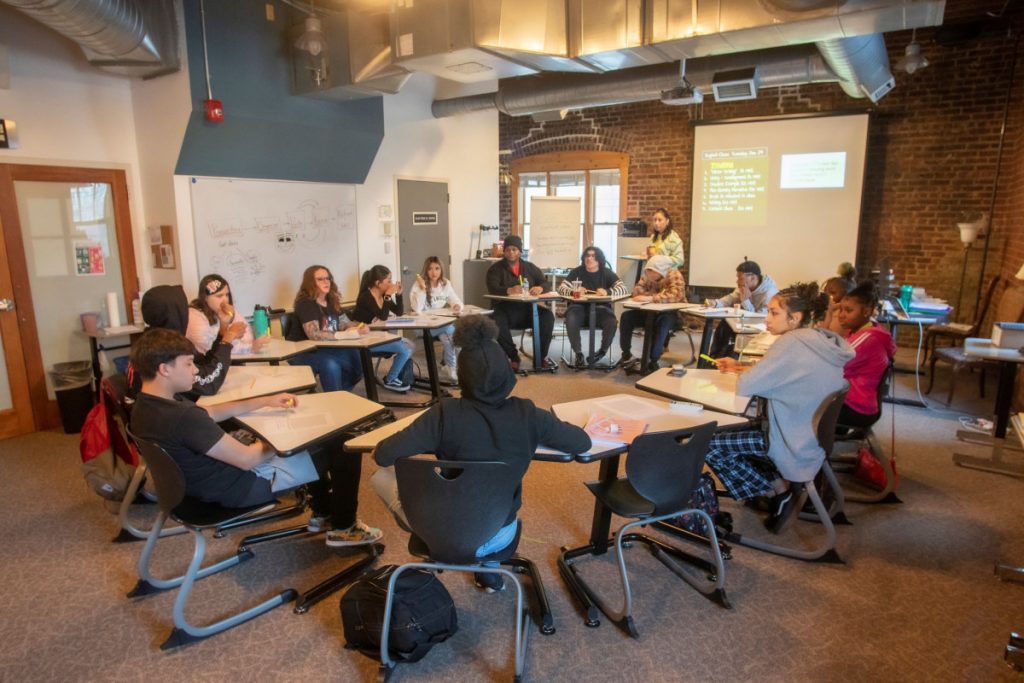Colorado has spent roughly $300 million to fulfill the goals of the 2012 READ Act. A bill to amend the Act will come before legislators this winter, in part to address one of the unexpected outcomes of all the hard work this past decade. The READ Act’s focus is K-3, but thousands of Colorado students still struggle to read well … even in high school.
The focus on the early grades made sense, for many years. In 2019 amendments to the original bill provided K-3 teachers the training they need to address their students’ reading difficulties. That change also provided training in evidence-based reading instruction to special education teachers and reading interventionists.
But look at the other end of the K-12 system. It tells us that our K-3 focus is not enough. Upon request, the Colorado Department of Education presents data on the number of high school students still on what is called “a READ plan.” The most recent data is from 2022-23.
K-3 students who have been “identified with a significant reading deficiency” are put on a READ plan, “an individualized approach to implementing instruction for that student.” This plan remains “part of the student’s academic record until the student achieves reading competency” (From Colorado’s Legislative Council Staff).
Those K-3 students first served by the READ Act 7-10 years ago are now in high school. This may surprise you: over 10,000 students are still on a READ plan in high school.
| High school students on a READ Plan, 2022-23 | Grade 9 | Grade 10 | Grade 11 | Grade 12 |
| 5,152 | 3,676 | 2,524 | 1,411 |
Equally disturbing: the total number has grown. An additional 3,600 students in two years.
| Total number of high school students on a READ Plan | 2021 | 2022 | 2023 |
| 9,093 | 11,127 | 12,763 |
And CDE’s data might well understate the true facts. In its report for high school students on a READ plan, data from over 140 districts is suppressed.
(A veteran teacher, a secondary reading interventionist in Aurora, adds another reason to believe these numbers do not reveal the size of the problem. “READ plans are only written up to 3rd grade,” she writes. “The numbers do not account for all of the students who fall behind after 3rd grade. There are many. Test data suggests as much as 2/3 of students.”)
Fortunately, most school districts in the metro area are willing to tally and record the number of their high school students on a READ plan, even when the figures are alarming. CDE’s reports show most of the state’s 12,763 high school students still on a READ plan in 2022-23 were enrolled in these ten districts.
| 10 metro districts –
largest to smallest – with READ Plan data available |
# of high school students on READ Plan for 2022-23 | # of 9th graders
on READ Plan for 2022-23 |
| Denver County | 3,909 | 1,423 |
| Jefferson County | 579 | 227 |
| Douglas County 1 | 878 | 337 |
| Cherry Creek | 549 | 339 |
| Adams-Arapahoe | 1,713 | 674 |
| Adams 12 Five Star Schools | 334 | 105 |
| Littleton | 136 | 76 |
| Westminster | 497 | 185 |
| Mapleton | 266 | 131 |
| Adams 14 | 294 | 121 |
| TOTAL | 9,155 | 3,618 |
The obvious question: why so many? Why, if these students were identified and received extra support all this time, were over 3,600 still unable to read well on entering high school?
To be sure, many were probably several grade levels behind in their K-3 years. They may have made real progress over time, and yet were still not proficient readers by 9th grade. And roughly half of those initially identified as struggling readers were eligible for special education services. For some, proficiency may be out of reach.
Still, recall the optimism of 2012. How the READ Act would “see all third graders reading at grade level.” We did not expect this.
The number of students at individual high schools on a READ plan is startling. We applaud districts like APS, DPS, and Westminster for presenting such eye-popping figures to the state. At the same time, who believes their high schools are prepared to meet the needs of so many struggling readers? With 419 students in Aurora Central and Westminster High who need extra support?
This list includes 26 Colorado high schools with over 100 students on a READ plan in both 2022 and 2023. Most schools—19—in Aurora and Denver. All but three in the metro area.
| 2020-21 | 2021-22 | 2022-23 | GRADE | |||||
| Grades 9-11 | Grades 9-12 | Grades
9-12 |
9 | 10 | 11 | 12 | ||
| 1 | Westminster High | 335 | 327 | 419 | 174 | 120 | 77 | 48 |
| 2 | Aurora Central H.S. (APS) | 203 | 290 | 419 | 135 | 131 | 95 | 58 |
| 3 | North High (DPS) | 196 | 271 | 296 | 114 | 74 | 66 | 42 |
| 4 | Adams City High School | 206 | 239 | 274 | 119 | 84 | 49 | 22 |
| 5 | Hinkley (APS) | 199 | 225 | 274 | 116 | 68 | 49 | 41 |
| 6 | Gateway High (APS) | 137 | 190 | 250 | 90 | 63 | 65 | 32 |
| 7 | Rangeview H.S. (APS) | 116 | 177 | 250 | 83 | 76 | 60 | 31 |
| 8 | Montbello H.S. (DPS) | 97 | 126 | 216 | 88 | 58 | 45 | 25 |
| 9 | Skyline H.S. (St. Vrain) | 75 | 130 | 176 | 72 | 57 | 29 | 18 |
| 10 | East High (DPS) | 124 | 153 | 167 | 52 | 49 | 45 | 21 |
| 11 | Douglas County H.S. | 96 | 126 | 156* | 67 | 60 | 29 | x |
| 12 | John F Kennedy (DPS) | 126 | 149 | 150 | 53 | 33 | 27 | 37 |
| 13 | Vista Peak 9-12 Preparatory (APS) | 57 | 101 | 149* | 76 | 57 | 16 | x |
| 14 | Dr. MLK. Jr. Early College (DPS) | 104 | 134 | 148 | 59 | 39 | 31 | 19 |
| 15 | Montrose H.S. | 88 | 131 | 147 | 50 | 44 | 36 | 17 |
| 16 | Aurora West College Prep (APS) | 65 | 106 | 147 | 62 | 40 | 29 | 16 |
| 17 | South High (DPS) | 120 | 151 | 146 | 46 | 38 | 38 | 24 |
| 18 | RMP Prep – Smart Academy (DPS) | 98 | 116 | 143 | 58 | 36 | 27 | 22 |
| 19 | Abraham Lincoln (DPS) | 182 | 224 | 140 | 40 | 50 | 33 | 17 |
| 20 | Thomas Jefferson H.S. (DPS) | 90 | 118 | 135 | 54 | 36 | 27 | 18 |
| 21 | KIPP NE Denver Leadership (DPS) | 86 | 100 | 132 | 52 | 31 | 25 | 24 |
| 22 | Northfield H.S. (DPS) | 71 | 114 | 127* | 63 | 43 | 21 | x |
| 23 | West High (DPS) | 66 | 141 | 123 | 40 | 38 | 25 | 20 |
| 24 | Loveland H.S. (Thompson R2-J) | 87 | 104 | 119 | 37 | 25 | 34 | 23 |
| 25 | George Washington H.S. (DPS) | 110 | 123 | 112* | 48 | 39 | 25 | x |
| 26 | Northglenn High (Adams 12) | 154 | 181 | 103* | 43 | 60 | x | x |
| TOTAL – 2021-2023 – increase of 1,630 | 3,288 | 4,247 | 4,918 | 1,891 freshmen in 2023 | ||||
* – 2022-23 – In these high schools, the numbers dropped sufficiently by 12th grade so the number was suppressed.
X – Suppressed in data collected and compiled by CDE.
Note the increase, overall, from roughly 3,300 to nearly 5,000, between 2021 and 2023.
Seven high schools added 100 or more students on a READ plan in just those two years.
Five high schools doubled their numbers in that time.
And those 1,891 freshmen in 2023? They are this year’s juniors. The Class of 2026. We often hear that, at a bare minimum, public education should make sure our graduates can read – and read well. Who believes we are meeting that goal?
We ask why these numbers are climbing. The high schools are not to blame. We must examine what is not happening before these students reach 9th grade.
This data is not telling us the READ Act has failed. But I trust we understand that to help our students struggling to catch up, our K-3 focus is not enough.
High school data paints a bleak picture, but we won’t solve the problem at that level. We must go further upstream. Back to grades 4, 5, and 6 especially. That’s where we see so much frustration; boys and girls trying to make sense of the words on the page.
That’s where teachers feel helpless. Most have not received training in how best to meet their students’ needs. At present, the READ Act’s funds do not reach them.
This next legislative session policy makers will have a chance to expand the reach of the READ Act. It cannot come soon enough.




